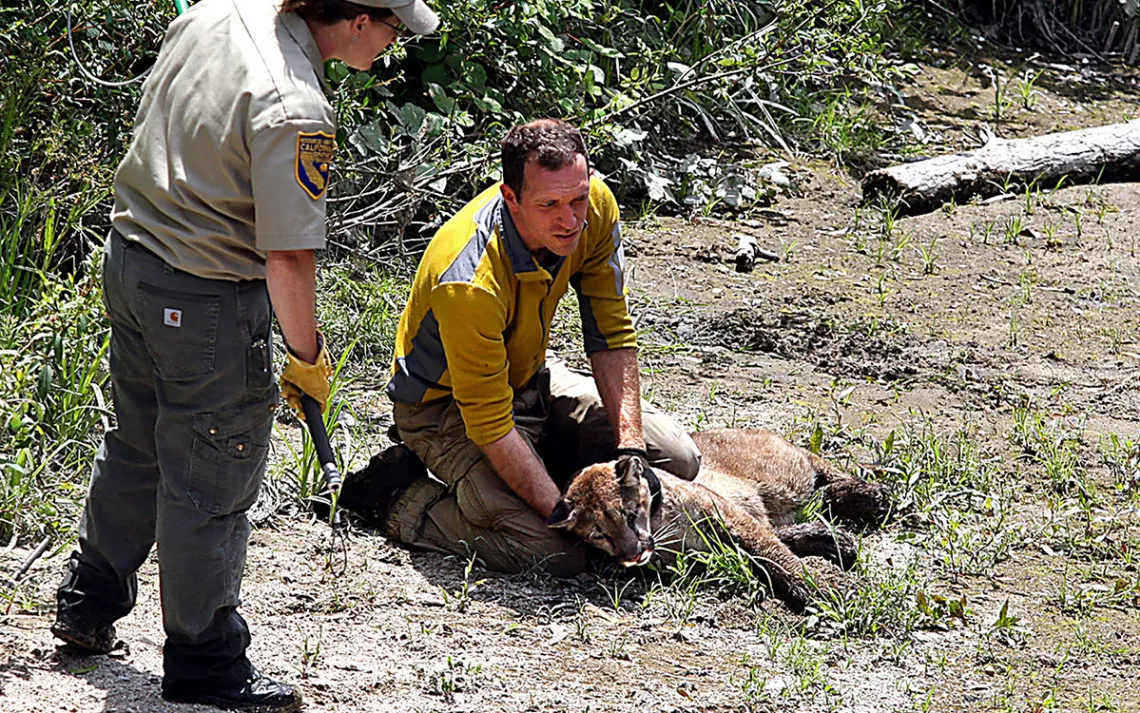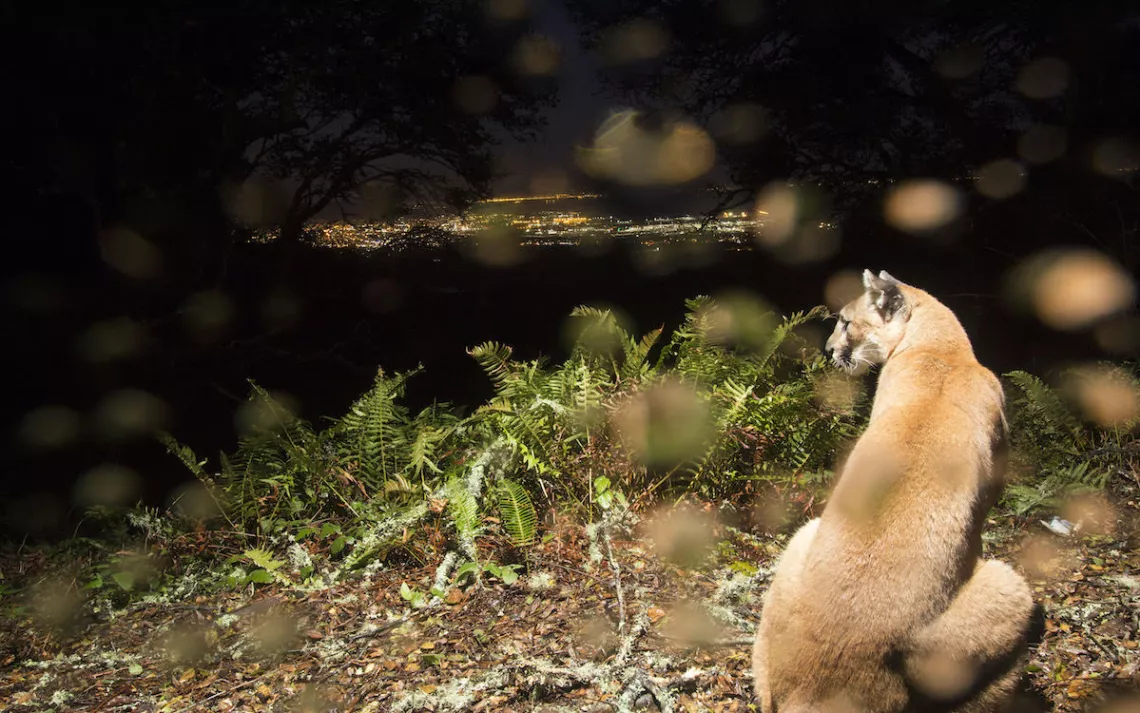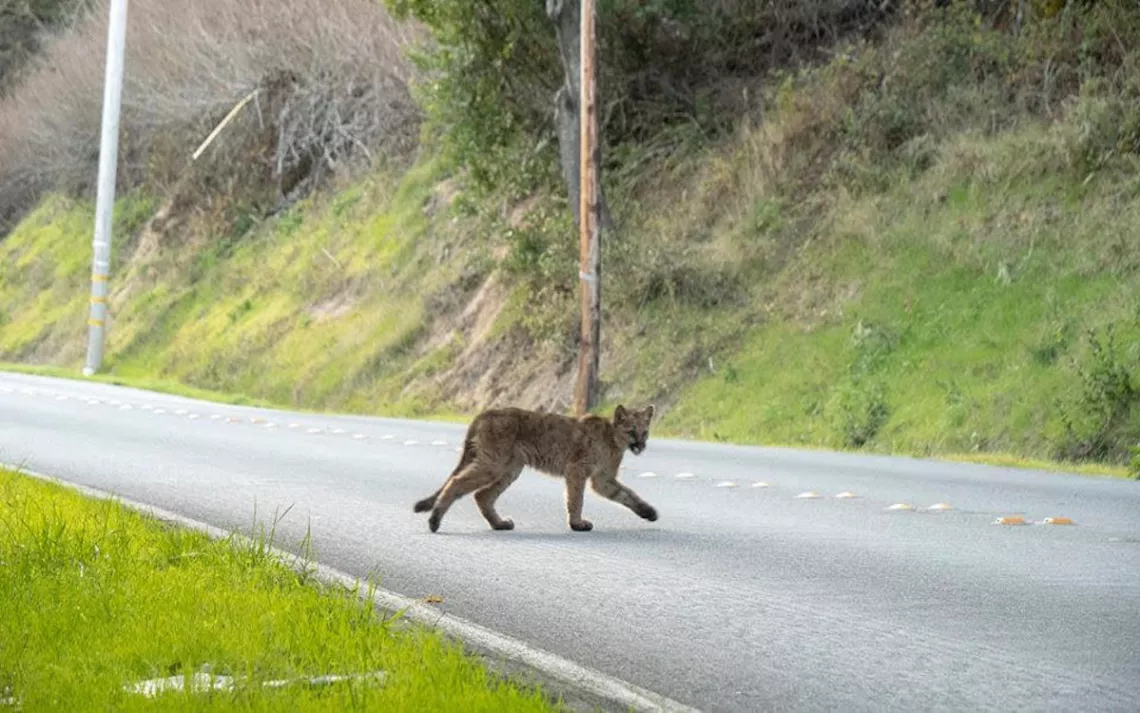Can Wildlife Corridors Save Mountain Lions?
Car travel poses the biggest danger to wildcats

Paul Houghtaling of the Santa Cruz Puma Project holds a tranquilized young male mountain lion found in an aqueduct near downtown Santa Cruz, California, in 2013. The lion was unable to get out of the concrete-walled aqueduct and had to be tranquilized before being measured, examined, tagged, collared, and finally released into the mountains above Santa Cruz. | Photo by AP Photo/Santa Cruz Sentinel, Dan Coyro
One early morning in October 2013, a young cat approached Highway 17 just past the Laurel Curve, the most dangerous segment of the highway connecting San Jose and Santa Cruz, California. Only about two years old, his pink nose was framed by patches of dark fur.
This puma, known to researchers at the Santa Cruz Puma Project as 39M, had made a name for himself a few months earlier as the “downtown puma” after getting lost near Ocean Street. Newly separated from his mother and on the hunt for territory of his own, 39M continued to venture into dangerous territory: first entering habitats occupied by rival males, then repeatedly crossing Highway 17, a roadway most pumas avoid.
As he crossed the highway that morning, his tracking collar went dark.
Every day, more than 65,000 vehicles travel on the winding Highway 17. This narrow passage is dangerous for both humans and animals, with the Laurel Curve being an especially accident-prone area. About one mountain lion is killed a year on Highway 17, making it their largest source of mortality. 39M’s death made him one of four mountain lions and 350 animals to be killed there from 2012 to 2017.
Highways like 17 are not only a danger to the animals for their potential to kill them outright. They also create habitat fragmentation with long-term consequences. As solitary, territorial animals, mountain lions need large amounts of land to roam. The Santa Cruz Mountains are an ideal mountain lion habitat. But because of Highway 17, explains Zara McDonald of the Bay Area Puma Project, the mountains have become an “island” where lions are stranded.

Photo courtesy of Felidae Conservation Fund/Bay Area Puma Project
Ten years ago, there were about 100 pumas in the Santa Cruz range. According to Chris Wilmers, a professor at UC Santa Cruz and the principal investigator at the Santa Cruz Puma Project, there are around 50. With not enough cats to support genetic diversity, the trapped pumas have started to mate with their own daughters and granddaughters: inbreeding that first causes kinked tails, then missing genitalia, and eventually extinction.
“They've got about 30 years before there's kind of a point of no return of the species,” said Laura Dannehl-Schickman, development and communications director of the Land Trust of Santa Cruz County.
With an extinction date looming, scientists and conservationists pushed for a solution. In February, Caltrans began construction on an 85-foot underpass that will stretch beneath Highway 17 at the Laurel Curve, a project that will provide a critical corridor for big cats. But more wildlife crossings are needed to truly sustain the area’s mountain lion population.
Highway 17 is not nearly the only impediment to the lions. “Connectivity is more complex than just crossing freeways, and the Bay Area has multiple areas where there are choke points for movements,” McDonald said. Open spaces like Marin County and Mt. Diablo would be great mountain lion habitat, she explained, but they are nearly impossible for the lions to access because of human development. Highways 101 and 280 in particular pose great physical and genetic threats. Even though the Highway 17 underpass will help, it won’t actually be enough to stop the lions’ eventual extinction from inbreeding.
“It’s really critical to be concerned about connectivity across the landscape,” said Seth Riley, a Wildlife branch chief for the National Park Service. Riley has been working on the Los Angeles version of Highway 17: the Liberty Canyon Wildlife Crossing, a huge overpass across Highway 101 that will allow mountain lions to leave the Santa Monica Mountains. This area is also an island habitat: Highway 101 is one of the busiest freeways in the world, with 350,000 cars passing daily. It’s incredibly dangerous to the cats. In July, a two-year-old male lion was the most recent casualty, joining a tally of seven cats killed this year on highways in the area. And Riley’s team has seen the same signs of inbreeding as in Santa Cruz: kinked tails, cryptorchidism (only one descended testis), and high levels of sperm abnormalities.
“We feel hopeful that we're not too far gone, but it has added a bit of a sense of urgency to see some of those physical signs of inbreeding,” said Riley. Ultimately, Riley hopes to connect the Santa Monica Mountains all the way to the Santa Cruz range.

Photo courtesy of Felidae Conservation Fund/Bay Area Puma Project
The Laurel Curve undercrossing is estimated to cost $12.5 million and expected to be completed by the end of the year. But not all crossings need to cost that much. “It's more symbolic to do the overpasses,” McDonald said. She explained that Caltrans could save money while still making a meaningful difference by clearing out culverts—structures next to or underneath a road meant for draining water. Animals can also use these tunnels to cross the road, but “lions stop using [culverts] when they can't see through to the other side or they're not big enough.”
Mountain lion survival is essential to preserving a healthy ecosystem. “Lions are what we call indicator species or keystone species; they provide multiple benefits,” McDonald explained. “They're taking care of diseased animals, keeping prey in check, making sure there's that fear on the landscape that keeps a prey species on guard and moving.” The apex predator’s demise has a cascading effect: In Marin, middle-size predators like coyotes and bobcats have exploded in population. Without pumas, deer populations, along with their tick-borne illnesses, also rise. It’s not clear what will happen if they disappear entirely, but that’s “not an experiment we want to conduct,” Riley said.
For Dannehl-Schickman, it’s about preserving the nature that is quintessentially Californian. “I grew up seeing mountain lions from far away. But also, I grew up learning how to scare off a mountain lion if I encountered it on a trail,” she said. “It’s an important feature.”
On the whole, Californians want them protected too. In 1990, Proposition 117 banned the hunting of lions, and after game wardens in Half Moon Bay killed two mountain lion cubs in 2012, the state legislature passed a bill encouraging nonlethal responses when the lions don’t pose an imminent threat to public safety. The California Fish and Game Commission is expected to consider permanent protections for Southern and Central Coast mountain lions under California’s Endangered Species Act.
In 2014, Wilmers wrote about another puma, 46M, who had recently been killed by a car on I-280. “The way he died is avoidable,” Wilmers wrote. “We could install wildlife crossing structures, such as underpasses or overpasses, when designing and retrofitting roads. Denmark, a country not much bigger than the Bay Area, has over 200 such wildlife crossing structures. Why not here?”
It’s not just Denmark: In Canada, wildlife crossings in Banff have reduced elk collisions to virtually zero and allowed grizzly bears to maintain genetic diversity. There’s even a crab bridge on Christmas Island in Australia. Now in California, Wilmers’s wish is inching closer to reality. In September, Governor Gavin Newsom signed the Safe Roads and Wildlife Protection Act, requiring Caltrans to identify wildlife barriers and develop crossing structures when working on roadways.
Some in the Bay Area show their support for the pumas by acting as citizen scientists. The Bay Area Puma Project gets much of its sightings data through these people, who have set up cameras around their houses to spot pumas. Some get really into it. Andy Forward, who lives on top of a hill in Pacifica, has 46 cameras.
“When [the cameras] get triggered, they send an email, which in theory means you know when [the cats] are here,” Forward said. “If it’s a windy day, you can get like 2,000 emails.”
He’s been tracking one female cat since she was a cub. She had a brother, but Forward believes he was killed on a highway in the Bay Area. So far, she has survived, and now she has cubs of her own.
“There’s two sides to it,” Forward said of watching the animals around him. “There’s a side to it which I find extremely great—it’s like wildlife, this nature being right outside your door—and then there’s a side of it which I find so depressing when you think of the fragility of that life.”
 The Magazine of The Sierra Club
The Magazine of The Sierra Club